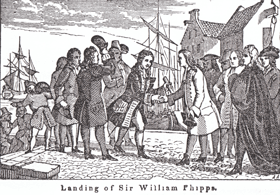The Setting of Salem
Witchcraft
Witchcraft and magic were as familiar to Puritan New Englanders as to their contemporaries in Europe. The practice of fortune-telling, palmistry, astrology, charms, and amulets co-existed with beliefs in witches and devils. What makes the events of 1692 stand out in American history is the scale and scope of the Salem outbreak. Previous encounters by colonial Americans with witchcraft were primarily brief incidents confined to a few people in one or two communities. In contrast, Salem was a full-fledged witch hunt. From its initial locus in the home and immediate neighborhood of Salem Village's minister, Rev. Samuel Parris, in early 1692, it spread over the landscape of New England. As the episode unfolded month after month, more than a score of communities were swept into its vortex. There had been nothing like it in colonial New England, or colonial America, for that matter.
In May 1692, Massachusetts officials, led by the newly arrived royal governor Sir William Phips, set up a special Court of Oyer and Terminer, with judges and juries, to try the increasing number of accused. It began its work on June 2, proceeding on the basis of indictments by grand juries. But the establishment of legal machinery to punish the guilty did not halt the eruption of new accusations. By October 1692, over 150 people had been jailed, a number of whom had confessed; many more, likely, had been accused, though no legal record remains. Nineteen people had been convicted and hanged, others found guilty but not yet executed, and one person, Giles Corey, died after a physical ordeal designed to coerce a formal plea so he could be tried. A few, including the baby of an accused witch, had died from the rigors of imprisonment.
Throughout the year, the numbers of afflicted, those who appeared to suffer harm directly by the accused and who could see the apparitions that caused their fits and pain, had swelled and extended beyond the original handful of Salem Villagers. While a core group of Salem Village young women remained key to the expanding witch hunt, women beyond their teenage years and even a few men also saw apparitions of witches, behaved in extraordinary ways, and accused others of causing harm. Many communities beyond Salem Village contributed their own indigenous sufferers. The Rev. John Hale, minister in nearby Beverly, observed that the number of those "afflicted by Satan" increased until about "Fifty persons were thus vexed by the Devil."
However, by October 1692, a reaction had clearly set in. In that month, Governor Phips restricted new accusations, halted further court proceedings and executions, and then dismissed the Court of Oyer and Terminer altogether. To handle existing cases, the government set up a Superior Court of Judicature, which met in January, April, and May 1693, using stricter standards of evidence to try cases. Of those it tried, only three were found guilty. Phips, however, reprieved these three, along with those who had been condemned but not yet executed by the previous court. In May 1693, the governor cleared the jails of all who could pay their fees. The Salem witch hunt, which had been effectually halted in October, was now over.
To learn about the start of the outbreak in Salem Village, click Next.
